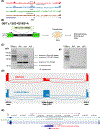Genome sequencing reveals the impact of pseudoexons in rare genetic disease
- PMID: 40927908
- PMCID: PMC12501780
- DOI: 10.1016/j.gim.2025.101574
Genome sequencing reveals the impact of pseudoexons in rare genetic disease
Abstract
Purpose: Advancements in sequencing technologies have significantly improved clinical genetic testing; yet, the diagnostic yield remains around 30% to 40%. Emerging technologies are now being deployed to address the remaining diagnostic gap.
Methods: We tested whether short-read genome sequencing could increase the diagnostic yield in individuals enrolled into the UCI-GREGoR research study, who had suspected Mendelian conditions and prior inconclusive testing. Two other collaborative research cohorts, focused on aortopathy and dilated cardiomyopathy, consisted of individuals who were undiagnosed but had not undergone harmonized prior testing.
Results: We sequenced 353 families (754 participants) and found a molecular diagnosis in 54 (15.3%) of them. Of these diagnoses, 55.5% were previously missed because the causative variants were in regions not originally interrogated. In 5 cases, they were deep intronic variants, all of which led to abnormal splicing and pseudoexons, as directly shown by RNA sequencing. All 5 of these variants had inconclusive spliceAI scores. In 26% of newly diagnosed cases, the causal variant could have been detected by exome sequencing reanalysis.
Conclusion: Genome sequencing can overcome limitations of clinical genetic testing, such as the inability to call intronic variants. Our findings highlight pseudoexons as a common mechanism via which deep intronic variants cause Mendelian disease.
Keywords: Genome sequencing; Intronic variants; Pseudoexon; RNA sequencing; Rare disease.
Copyright © 2025 The Authors. Published by Elsevier Inc. All rights reserved.
Conflict of interest statement
Conflict of Interest Megan Hawley, Jianhua Zhao, and Kaylee Scozzaro are currently employees of Labcorp Genetics Inc, formerly known as Invitae Corp; Ingrid Chen is a former employee of Invitae Corp. All other authors declare no conflicts of interest.
Figures





Update of
-
Genome sequencing reveals the impact of pseudoexons in rare genetic disease.medRxiv [Preprint]. 2025 Jun 18:2024.12.21.24318325. doi: 10.1101/2024.12.21.24318325. medRxiv. 2025. Update in: Genet Med. 2025 Sep 6;27(11):101574. doi: 10.1016/j.gim.2025.101574. PMID: 39763557 Free PMC article. Updated. Preprint.
References
-
- Jaganathan K, et al. , Predicting Splicing from Primary Sequence with Deep Learning. Cell, 2019. 176(3): p. 535–548 e24. - PubMed
Grants and funding
LinkOut - more resources
Full Text Sources
Miscellaneous

